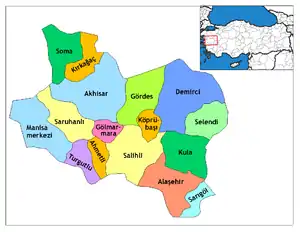Manisa
Manisa (Turkish pronunciation: [maˈnisa]), historically known as Magnesia (Greek: Μαγνησία), is a large city in Turkey's Aegean Region and the administrative seat of Manisa Province.
Manisa | |
|---|---|
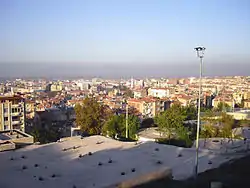 Manisa's view from the Ulu Mosque | |
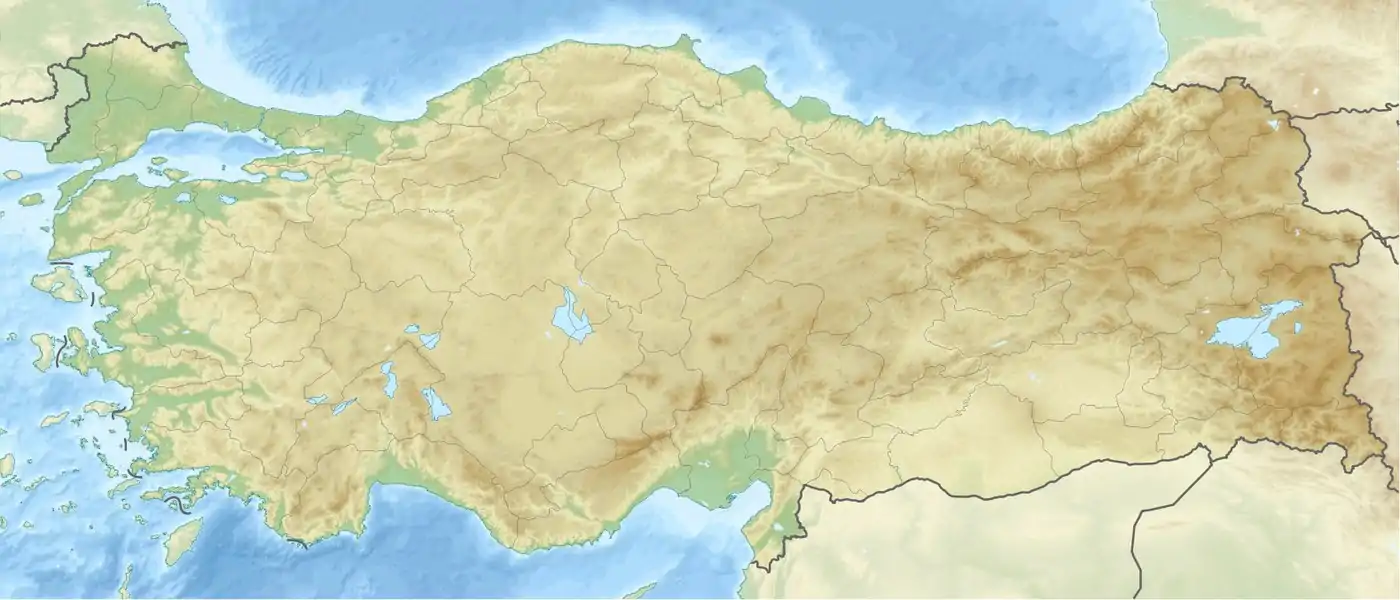 Manisa  Manisa | |
| Coordinates: 38°37′50″N 27°25′20″E | |
| Country | |
| Province | Manisa |
| Government | |
| • Mayor | Cengiz Ergün (MHP) |
| Area | |
| • District | 13,339 km2 (5,150 sq mi) |
| Elevation | 71 m (233 ft) |
| Population (2012) | |
| • District | 356,702 |
| • District density | 27/km2 (69/sq mi) |
| Time zone | UTC+3 (TRT) |
| Website | www |
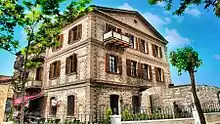
Modern Manisa is a booming center of industry and services, advantaged by its closeness to the international port city and the regional metropolitan center of İzmir and by its fertile hinterland rich in quantity and variety of agricultural production. In fact, İzmir's proximity also adds a particular dimension to all aspects of life's pace in Manisa in the form of a dense traffic of daily commuters between the two cities, separated as they are by a half-hour drive served by a fine six-lane highway nevertheless requiring attention at all times due to its curves and the rapid ascent (sea-level to more than 500 meters at Sabuncubeli Pass) across Mount Sipylus's mythic scenery.
The historic part of Manisa spreads out from a forested valley in the immediate slopes of Sipylus mountainside, along Çaybaşı Stream which flows next to Niobe's "Weeping Rock" ("Ağlayan Kaya"), an ancient bridge called the "Red Bridge" ("Kırmızı Köprü") as well as to several tombs-shrines in the Turkish style dating back to the Saruhan period (14th century). Under Ottoman rule in the centuries that followed, the city had already extended into the undulated terrain at the start of the plain. In the last couple of decades, Manisa's width more than tripled in size across its vast plain formed by the alluvial deposits of the River Gediz, a development in which the construction of new block apartments, industrial zones and of Celal Bayar University campus played a key role.
The city of Manisa is also widely visited, especially during March and September festivals, the former festival being the continuation of a five-hundred-year-old "Mesir Paste Distribution" tradition, and also for the nearby Mount Spil national park. It is also a departure point for other visitor attractions of international acclaim which are located nearby within Manisa's depending region, such as Sardes and Alaşehir (ancient Philadelphia) inland. The city also has a Jewish community.[2]
Name and etymology
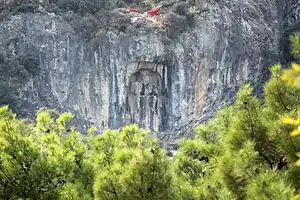
Historically, the city was also called Magnesia (Greek: Μαγνησία), and more precisely as Magnesia ad Sipylum to distinguish from Magnesia on the Maeander at a relatively short distance to the south. Traditional view held that the name "Magnesia" derived from the tribe of Magnetes who would have immigrated here from Thessaly at the dawn of the region's recorded history. A connection with native Anatolian languages has also been suggested of recent date, particularly on the basis of discoveries made in the Hittite archives treating the Luwian western Anatolia. The name is rendered as Μαγνησία in ancient and modern Greek language.
The name "Magnesia ad Sipylus" refers to Mount Sipylus (Mount Spil) that towers over the city and Magnesia became a city of importance starting with the Roman dominion, particularly after the 190 BC Battle of Magnesia. The names "Sipylus" or "Sipylum" in reference to a settlement here are also encountered in some sources, again in reference to the mountain and as abbreviated forms. Pliny the Elder, supported by other sources, mentions that formerly in the same place was a very celebrated city which was called "Tantalis" [3] or "the city of Tantalus" whose ruins were still visible around his time.[4]
Under Turkish rule, the name attached to the Beys of "Saruhan", who founded the Beylik which preceded the Ottomans in the region, has been officially used, along with the name Manisa, for the city and the region alternatively and this until the present period of the Republic of Turkey. The Ottoman Turkish form of the name "Manisa" (ماغنيسا) was usually as it is still used presently, but a spelling with a longer first syllable, transcribed to modern Turkish as "Mağnisa", was also occasionally encountered. During the first centuries of the Ottoman Empire, many of the sons of sultans received their education in Manisa and the city is still commonly known in Turkey as "the city of shahzades" (Şehzadeler şehri), a distinctive title it shares only with Amasya and Trabzon.
The English language root word "magnesia", from which the words "magnet" and "magnetism" and numerous other derivations were coined, as well as their equivalents in many other languages, may derive from the city's name.
History
%252C_Roman_period%252C_Archaeological_Museum_of_Manisa%252C_Turkey_(31313938383).jpg.webp)
Prehistory
Traces of prehistory in the Manisa region, although few in number, nevertheless include two very interesting finds that shed much light on western Anatolia's past. The first are the fossilized footprints, numbering more than fifty and dated to around 20.000-25.000 BC, discovered in 1969 by MTA, Turkey's state body for mineral exploration, in Sindel village near Manisa's depending district of Salihli and referred to under that village's name. Some of these footprints are on display today in Manisa Museum while their site of origin of Sindel, where there are also prehistoric paintings, will reportedly become Turkey's first geopark through a joint project with the European Commission.
The second finds are tombs contemporaneous with Troy II (3000-2500 BC) and found in the village of Yortan near Kırkağaç district center, north of Manisa. Original burial practices observed in these sepulchres led scholars to the definition of a "Yortan culture" in Anatolia's prehistory, many of whose aspects remain yet to be explored.[5]
Luwians, Hittites, Phrygians and Lydians
Central and southern parts of western Anatolia entered history with the still obscure Luwian kingdom of Arzawa, probably offshoots, as well as neighbors and, after around 1320 BCE, vassals of the Hittite Empire. Cybele monument located at Akpınar on the northern flank of Mount Sipylus, at a distance of 7 km (4 mi) from Manisa on the road to Turgutlu is, along with the King of Mira rock relief at Mount Nif near Kemalpaşa and a number of cuneiform tablet records are among the principal evidence of extension of Hittite control and influence in western Anatolia based on local principalities. Cybele monument by itself represents a step of innovation in Hittite art where full-faced figures in high relief are rare. The first millennium BC saw the emergence in the region of "Phrygians" and "Maeonians", the accounts concerning which are still blended with myths,[lower-alpha 1] and finally of Lydians. Such semi-legendary figures like the local ruler Tantalus, his son Pelops, his daughter Niobe, the departure of a sizable part of the region's population from their shores to found, according to one account, the future Etruscan civilization in present-day Italy, are all centered around Mount Sipylus, where the first urban settlement was probably located, and date from the period prior to the emergence of the Lydian Mermnad dynasty. It has also been suggested that the mountain could be the geographical setting for Baucis and Philemon tale as well, while most sources still usually associate it with Tyana (Hittite Tuwanuwa) in modern-day Kemerhisar near Niğde.[6]
In the early 7th century BC, the Lydians under the newly established Mermnad dynasty, with the present-day Manisa region as their heartland expanded their control over a large part of Anatolia, ruling from their capital "Sfard" (Sard, Sardes, Sardis) situated more inland at a distance of 62 km (39 mi) from Manisa. The vestiges from their capital which reached our day bring together remains from several successive civilizations.
Hellenistic, Roman and Byzantine periods
.jpg.webp)
In classical antiquity, Romans knew the city as Magnesia ad Sipylum. There, in 190 BC, forces of the Roman Republic defeated the Seleucid king Antiochus the Great in the Battle of Magnesia. Magnesia ad Sipylum became a city of importance under Roman rule, and though nearly destroyed by an earthquake in the reign of Tiberius (Roman Emperor from 14 AD to 37 AD), was restored by that emperor and flourished through the period of the Roman empire.
In 1076 the Byzantine Empire lost the city to the Seljuks in the aftermath of the 1071 Battle of Manzikert.The subsequent Crusader victory at the Battle of Dorylaeum (1097) allowed the Byzantine Emperor Alexios I to recover Magnesia. It was an important regional centre under Byzantine rule, and during the 13th-century interlude of the Empire of Nicea of 1204 to 1261. Magnesia housed the Imperial mint, the Imperial treasury, and served as the functional capital of the Empire of Nicea until the recovery of Constantinople in 1261.[7] Ruins of the Nicean-era fortifications attest to the city's importance in the Late Byzantine period, a fact also noted by the Byzantine historian George Akropolites, writing in the 13th century.
Turkish era (Seljuk, Saruhan and early Ottoman periods)
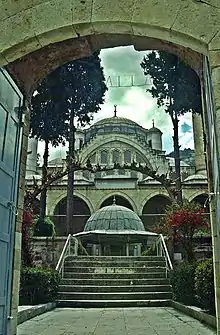
| Year | Pop. | ±% |
|---|---|---|
| 1531 | 6,500 | — |
| 1575 | 8,250 | +26.9% |
| 1911 | 35,000 | +324.2% |
| 1927 | 28,328 | −19.1% |
| 1935 | 36,431 | +28.6% |
| 1960 | 77,464 | +112.6% |
| 1980 | 111,228 | +43.6% |
| 2000 | 149,151 | +34.1% |
In the early 13th century the region of Magnesia was subject to repeated raids by invading Turkish bands.[8] The local population was unable to repulse the Turkish raids. Thus, after an unsuccessful defence led by the Byzantine Emperor most inhabitants fled to the Aegean coast and the European part of the Byzantine Empire.[8] As a result of the Turkish invasion in the region and the destruction of the city the area was largely abandoned.[8] In 1313, Manisa became a permanent Turkish possession when taken by the Beylik of Saruhan, led by the Bey of the same name who had started out as a tributary of the Seljuks and who reigned until 1346. His sons held the region until 1390, when the first incorporation of their lands into the expanding Ottoman state took place. After a brief interval caused by the Ottoman interregnum after the Battle of Ankara, Manisa and its surroundings definitely became part of the Ottoman Empire in 1410.
Even during the 15th century Magnesia was recorded as being in complete ruins due to the previous Turkish raids.[8] As the central town of the Ottoman Empire's Saruhan sanjak, the city became the training ground for shahzades (crown princes), and it stood out as one of the wealthiest parts of the Empire with many examples of Ottoman architecture built. In a practice started by Murad II in 1437, fifteen members of the Ottoman dynasty, including two among the most notable, namely Mehmed II and Süleyman I, held the administration of the city and of its dependencies in seventeen near-continuous periods until 1595. Although the sanjak of Saruhan officially depended on the eyalet of Anadolu with its seat in Kütahya, a large degree of autonomy was left to the princes for them to acquire the experience of government. This practice was discontinued in 1595, largely due to the growing insecurity in the countryside, precursor of Jelali Revolts, and a violent earthquake dealt a severe blow to the Manisa region's prosperity the same year.
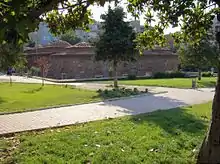
Around 1700, Manisa counted about 2,000 taxpayers and 300 pious foundations (vakıf) shops, was renowned for its cotton markets and a type of leather named after the city. Large parts of the population had begun settling and becoming sedentary and the city was a point of terminus for caravans from the east, with İzmir's growth still in its early stages.[9] But already during the preceding century, influent western merchants such as Orlando, often in pact with local warlords such as Cennetoğlu, a brigand (sometimes cited as one of the first in line in western Anatolia's long tradition of efes to come) who in the 1620s had assembled a vast company of disbanded Ottoman soldiers and renegades and established control over much of the fertile land around Manisa, had triggered a movement of more commercially sensitive Greek and Jewish populations towards the port city.[10]
Late-Ottoman Manisa

Between 1595–1836, the sanjak of Saruhan (Magnesia) remained attached to the Eyalet of Anadolu, as in the time of the Ottoman crown princes. Between 1836–1867 the city and its depending region was made part of the short-lived Eyalet of Aydın, which became a vilayet with the administrative reforms of 1867. During this phase, Saruhan (Manisa) even had an eyalet of its own under its name as the "Eyalet of Saruhan" between the even shorter period 1845–1847. The seat of the province to which Saruhan sanjak depended was the city of Aydın (1827–1841 and 1843–1846) at first, and was later moved to Smyrna (1841–1843, 1846–1864).
Magnesia was one of the first cities in the Ottoman Empire to benefit from the arrival of a railway line, with the 93 km (58 mi) Smyrna Cassaba Railway, whose construction was started from Smyrna in 1863 and which reached its first terminus at Manisa's depending Kasaba in 1866. This railway was the third started within the territory of the Ottoman Empire at the time and the first finished within the present-day territory of Turkey.[lower-alpha 2] Instead of being laid along the direct route eastwards from Smyrna to Kasaba, about fifty kilometers in length, the line built drew a wide arc advancing first to the north-west from İzmir, through its Karşıyaka suburb to whose foundation it contributed greatly, and curves eastwards only from Menemen on, crossing the former sanjak and the present-day province center of Manisa to join Kasaba (now Turgutlu) from the north. The first concession under the name was granted to a locally based English entrepreneur named Edward Price, who founded the company and built the line. This railway was extended further east by the same company between 1872–1875 to reach Alaşehir at a distance of 76 km (47 mi) from Kasaba and a connection northwards starting from Manisa itself was built between 1888–1890 to reach the lignite-rich Soma, another dependency of Manisa, through a 92 km (57 mi) line. Price sold the whole network in 1893 to the Franco-Belgian group Compagnie Internationale des Wagons-Lits, which extended it further east to Afyonkarahisar in 1896 and further north to Bandırma in 1912.[11] The line was nationalized in 1934 by the young Republic of Turkey in the frame of a general move started in the 1920s regarding Turkey's railways.
20th century

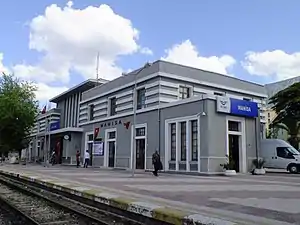
After the Young Turk revolution (1908) the local Greek community was subject to wide scale boycott, as noted by the local British ambassador.[12] Magnesia was temporarily occupied by the Greek Army on May 26, 1919 during the Greco-Turkish War (1919-1922), before finally being recaptured by the Turkish army on September 8, 1922. The retreating Greek army burned the city. Over ninety percent of Magnesia was destroyed by the retreating Greek army as part of the scorched-earth policy.[13] James Loder Park, the U.S. Vice-Consul in Constantinople at the time, who toured much of the devastated area immediately after the Greek evacuation, described the situation in the surrounding cities and towns of Smyrna he has seen, as follows:[14] "Magnesia...almost completely wiped out by fire...10,300 houses, 15 mosques, 2 baths, 2,278 shops, 19 hotels, 26 villas...[destroyed]." Patrick Balfour, 3rd Baron Kinross wrote: "Out of the eighteen thousand buildings in the historic holy city of Magnesia, only five hundred remained."[15]
Magnesia was rebuilt and became the centre of Saruhan Province in 1923 under the new Turkish Republic. The province's name was changed to Manisa, as was the city itself, in 1927.
Climate
Manisa has a Mediterranean climate with hot, dry summers lasting a long time and winters being short and cool. Summers in Manisa are hotter than the coast with its western neighbour İzmir lying on the Aegean Sea and winters being colder due to its inland location.
Records began in 1930. Highest temperature was 45.5 °C in July 2007. Lowest temperature was -17.5 °C in January 1942. Highest snow depth was 44 cm in January 1945.
| Climate data for Manisa (Averages: 1975-2010)(Records: 1930-2018) | |||||||||||||
|---|---|---|---|---|---|---|---|---|---|---|---|---|---|
| Month | Jan | Feb | Mar | Apr | May | Jun | Jul | Aug | Sep | Oct | Nov | Dec | Year |
| Record high °C (°F) | 24.0 (75.2) |
26.4 (79.5) |
33.5 (92.3) |
34.7 (94.5) |
39.5 (103.1) |
42.4 (108.3) |
45.5 (113.9) |
44.5 (112.1) |
42.4 (108.3) |
37.3 (99.1) |
29.9 (85.8) |
26.4 (79.5) |
45.5 (113.9) |
| Average high °C (°F) | 10.7 (51.3) |
12.2 (54.0) |
16.2 (61.2) |
21.2 (70.2) |
27.2 (81.0) |
32.5 (90.5) |
35.2 (95.4) |
35.0 (95.0) |
30.6 (87.1) |
24.2 (75.6) |
16.9 (62.4) |
11.9 (53.4) |
22.8 (73.1) |
| Average low °C (°F) | 3.0 (37.4) |
3.6 (38.5) |
5.5 (41.9) |
9.3 (48.7) |
13.7 (56.7) |
18.3 (64.9) |
21.2 (70.2) |
21.0 (69.8) |
16.6 (61.9) |
12.4 (54.3) |
7.3 (45.1) |
4.7 (40.5) |
11.4 (52.5) |
| Record low °C (°F) | −17.5 (0.5) |
−10.9 (12.4) |
−6.7 (19.9) |
−2.7 (27.1) |
2.0 (35.6) |
7.4 (45.3) |
10.5 (50.9) |
8.5 (47.3) |
3.3 (37.9) |
−0.9 (30.4) |
−7.3 (18.9) |
−9.9 (14.2) |
−17.5 (0.5) |
| Average precipitation mm (inches) | 110.7 (4.36) |
98.4 (3.87) |
79.9 (3.15) |
56.1 (2.21) |
32.3 (1.27) |
15.5 (0.61) |
9.5 (0.37) |
7.9 (0.31) |
22.0 (0.87) |
50.5 (1.99) |
97.0 (3.82) |
129.5 (5.10) |
709.3 (27.93) |
| Average rainy days | 11.2 | 10.8 | 9.2 | 9.3 | 6.4 | 3.2 | 2.1 | 1.5 | 3.3 | 6.1 | 9.4 | 12.9 | 85.4 |
| Mean monthly sunshine hours | 89.9 | 106.4 | 170.5 | 201.0 | 275.9 | 327.0 | 356.5 | 334.8 | 279.0 | 201.5 | 123.0 | 74.4 | 2,539.9 |
| Source: Devlet Meteoroloji İşleri Genel Müdürlüğü [16] | |||||||||||||
Health
Air pollution in Turkey is a chronic problem here.[17]
Architectural landmarks

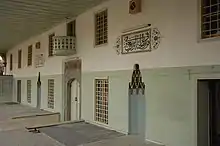
The 16th century Sultan Mosque was built for Ayşe Hafsa Sultan, Süleyman the Magnificent's mother. In her honor, Mesir Festival (featuring the "Mesir Paste" (Turkish: Mesir Macunu), a spiced paste in the form of candy, and claimed to restore health, youth and potency, is held every year in March, in the grounds of this mosque, and is an occasion for public gathering as well as attendance by personalities of fame and prominence at national scale.
The mosque is part of a large külliye - a religious complex - among whose buildings the hospital "darüşşifa" is particularly notable. Specialized in mental diseases, the medical center was in activity until the beginning of the 20th century when new buildings were built within the same compound. That Turkey's only two institutions specialized on mental health were until recently located in İstanbul district of Bakırköy and in Manisa gave way in Turkey's public lore to gentle innuendos on the challenging spirit of the natives - Manisalı.
One such likeable eccentric of the 20th century was Ahmet Bedevi, the Tarzan of Manisa or "Manisa Tarzanı", a figure who became a symbol for the city by contributing to raising consciousness for protection of the environment across Turkey and a reference especially since the 1960s when an important reforestation effort covering thousands of hectares was made in and around Manisa.[18]
The Muradiye Mosque of the 16th century was built by the great architect Mimar Sinan (and completed by Sedefkar Mehmed Agha), and the 'Murad Bey Medresse now houses the Archaeological Museum of Manisa.
Manisa celebrates the Vintage Festival every September, when the fruits of the vineyards are celebrated. The vineyards surround the city and provide dry fruit for export from İzmir, and grapes for wine making.
Modern Manisa

Manisa and some of its depending district centers have succeeded in solidly clinching an industrial production base in recent decades, in this supported both initially and continuously by the century-old wide-scale agricultural processing and related activities (production of flour and olive oil, basic textiles, leather goods, agricultural tools and instruments, cotton ginning).
According to the figures published by the Governorship, 694 companies in Manisa Province out of the province's total number of companies of 5,502 for 2007 are certified industrial enterprises and these employ a total of 44,449 people. Within the 694, Manisa center is in the lead with 238 enterprises engaged in industrial production, with the depending centers of Turgutlu (125 industrial enterprises), Akhisar (100), Salihli (78) closely contending, and Saruhanlı (33), Alaşehir (30), Kula (28), Demirci (20) and Soma (17) following.[lower-alpha 3]
Among leading industrial activities Manisa companies are engaged in are production of foodstuffs (196 companies), building materials (114), metal goods (85), as well as textile industry and clothing industry (46) and cotton ginning (43). The highest numbers of workforce are concentrated in electronics/electrical appliances, foodstuffs and construction industries.
The choice of Manisa as production base in the 1980s by the Turkish consumer electronics and white goods giant Vestel was an important boost for the present-day level of sophistication. Today Manisa's economic activities are far from being confined to a sole company. Manisa registered roughly 200m US dollars in FDI in 2004 and well-known businesses such as Italian white goods company Indesit, German electrical goods company Bosch, UK packaging company Rexam and Imperial Tobacco of the UK have invested in Manisa.
In 2004/2005 Manisa was chosen among 200 contestants as the Most Cost-Effective European city by the FDi magazine's yearly round of votes to determine European Cities and Regions of the Future, its extremely low office and industrial rents and competitive labor costs having been particularly noted.[19] Again for 2006/2007, Manisa was named among 89 European cities as the winner of the category of the Best Economic Potential in Europe, as runner-up for the categories Southern-Europe's City of the Future (winner for Turkey) and the Most Cost-Effective European city.[20]
The city also has a football team, Manisaspor, which plays in the Turkish Premier Super League under the home colors of red and white and away colors of black and white. Manisaspor's home ground is the Manisa 19 Mayis Stadi.
Notable natives

Early period
Greco-Roman period
- Pausanias (geographer) (possibly) - Greek traveller, geographer, and writer of the 2nd century AD
Saruhan-Ottoman period
- Saruhan dynasty - Turkish Beylik dynasty which ruled Manisa region in the 14th century
- Lala Mehmed Pasha - Ottoman grand vizier of the 16th century
- Gelenbevi Ismail Efendi - Ottoman mathematician and academic
- Karaosmanoğlu family - Dynasty of regional lords (ayan) who governed with great autonomy between mid-18th and mid-19th century from their bases in Akhisar, Manisa and İzmir and also produced notable members later such as the author Yakup Kadri Karaosmanoğlu
- Gregory (Orologas), Greek Orthodox metropolitan bishop of Ayvalik, executed by the Turkish Army in 1922
Turkish Republic
- Ahmet Bilek - Olympic gold medalist in wrestling
- Ahmet bin Carlak, aka Tarzan of Manisa - environmentalist
- Asuman Dabak - Film and theater actress
- Caner Erkin - Football player
- Demet Evgar - Film and theater actress
- Hilmi Özkök - General and former Chief of the General Staff of Turkey
- İlhan Berk - Poet
- Kenan Evren - General, military coup leader and 7th President of Turkey
- Ruhi Sarıalp - Olympic bronze medalist in triple jump
- Sinan Erdem - former volleyball player and head of Turkish National Olympic Committee
- Yusuf Atılgan - Novelist and dramatist
See also
International relations
In recent years, many studies have been conducted to inform the foreign public opinion. For this purpose, the website of www.manisahistory.com has started to be streamed within the scope of the Meeting Point of History and Civilization: Manisa project carried out by the Manisa Culture, Art and Tourism Association (MAKSAT) by the Manisa Culture, Art and Tourism Association (MAKSAT) the Meeting Point of History and Civilization: Manisa project conducted by the Manisa Culture, Art and Tourism Association (MAKSAT).
Notes
- While some sources claim that "Meonian" was an earlier name for a "Lydian", another theory holds that Meonians may have preceded Lydians in the region and would have continued their existence as a substratum within the Lydian society, neighboring theirs especially in the mountainous region to the south. While most of what the Lydians could tell about themselves is lost and historians have to rely on secondary sources, a village locally still called "Menye" (officially Gökçeören) exists between the district centers of Kula and Salihli. Ancient traces rich in quantity are visible to the naked eye around the village and preliminary surface explorations have only recently started.
- A short line built in Dobruja (now in Romania) was started and finished earlier, and İzmir-Aydın railway was started earlier in 1856 but finished a year after Smyrna Cassaba Railway in 1867.
- The counts given exclude Soma's lignite mines (10 million tonnes produced in 2007) and thermal power plant (7 billion kWh electricity production in 2007).
Sources
- Manisa (in Turkish). Governorship of Manisa. April 2007.
- George E. Bean (1967). Aegean Turkey: An archaeological guide. Ernest Benn, London. ISBN 978-0-510-03200-5.
- Rosie Ayliffe, Marc Dubin and John Gawthrop (2003). The rough guide to Turkey. Rough Guides. p. 313. ISBN 1-84353-071-6.CS1 maint: uses authors parameter (link)
- "Area of regions (including lakes), km²". Regional Statistics Database. Turkish Statistical Institute. 2002. Retrieved 2013-03-05.
- Avotaynu: the international review of Jewish genealogy, Volume 14, G. Mokotoff, 1998, p. 40.
- George Perrot (2007). History of Art In Phrygia, Lydia, Caria And Lycia (in French and English). Marton Press. p. 62. ISBN 978-1-4067-0883-7.
- James George Frazer (1965) [1900]. Pausanias, and other Greek sketches, later retitled Pausanias's Description of Greece. Kessinger Publishing Company. ISBN 978-1-4286-4922-4.
- K. Lambrianides (1992). "Preliminary survey and core sampling on the Aegean coast of Turkey". Anatolian Studies. 42: 75–78. doi:10.2307/3642952. JSTOR 3642952.
- C.P.Jones (1994). "A Geographical Setting for the Baucis and Philemon Legend (Ovid Metamorphoses 8.611-724)". Harvard Studies in Classical Philology. 96: 203–223+I–IV. doi:10.2307/311324. JSTOR 311324.
- George Akropolites, The History (Ruth Macrides, ed.), Oxford, University Press, 2007, p. 171.
- Speros Vryonis, Jr. (2008). The decline of medieval Hellenism in Asia Minor and the process of Islamization from the eleventh through the fifteenth century. New York: American Council of Learned Societies. pp. 252, 254, 259. ISBN 978-1597404761.
- Karen Barkey (1994). Bandits and Bureaucrats: the Ottoman route to state centralization. Cornell University Press. p. 243 Appendix I: The Study Area. ISBN 0-8014-8419-7.
- Edhem Eldem; Daniel Goffman; Bruce Alan Masters (1999). "İzmir: From village to colonial port city". The Ottoman City Between East and West: Aleppo, İzmir, and Istanbul. Cambridge University Press. p. 91. ISBN 0-521-64304-X.
- Ralf Roth; Günter Dinhobl, eds. (2008). Across the Borders: Financing the World's Railways in the Nineteenth and Twentieth Centuries. Ashgate Publishing. p. 188. ISBN 978-0-7546-6029-3.
- Shirinian, George N. (2017). Genocide in the Ottoman Empire: Armenians, Assyrians, and Greeks, 1913–1923. Berghahn Books. p. 43. ISBN 9781785334337.
In small towns such as Magnesia..., and throughout the villages where the ubiquitous Greek petty trader is to be found, boycotting in a most severe form is being carried on. All Moslems or Greeks who are found entering raya shops are beaten, and all semblance of free commerce or equality is at an end while as things tend at present, the position of the Greeks and Armenians in many districts is becoming more and more untenable.
- Rosie Ayliffe, Marc S. Dubin, Terry Richardson, John Gawthrop (2003). Turkey. p. 313.CS1 maint: uses authors parameter (link)
- U.S. Vice-Consul James Loder Park to Secretary of State, Smyrna, 11 April 1923. US archives US767.68116/34
Consul Park concluded:
"1. The destruction of the interior cities visited by our party was carried out by Greeks."
"2. The percentages of buildings destroyed in each of the last four cities referred to were: Magnesia 90 percent, Cassaba (Turgutlu) 90 percent, Philadelphia 70 percent, Salihli 65 percent."
"3. The burning of these cities was not desultory, nor intermittent, nor accidental, but well planned and thoroughly organized."
"4. There were many instances of physical violence, most of which was deliberate and wanton. Without complete figures, which were impossible to obtain, it may safely be surmised that 'atrocities' committed by retiring Greeks numbered well into thousands in the four cities under consideration. These consisted of all three of the usual type of such atrocities, namely murder, torture and rape." - Kinross, Lord (1960). Atatürk: The Rebirth of a Nation. Weidenfeld & Nicolson. p. 318. ISBN 978-0-297-82036-9.
- "İl ve İlçelerimize Ait İstatistiki Veriler" [Statistical Data of Provinces and Districts] (in Turkish). Devlet Meteoroloji İşleri Genel Müdürlüğü [General Directorate of State Meteorological Affairs]. Archived from the original on 2011-04-30. Retrieved 2011-03-19.
- Kara Rapor 2020: Hava Kirliliği ve Sağlık Etkileri [Black Report 2020: Air Pollution and Heath Effects] (Report) (in Turkish). Right to Clean Air Platform Turkey. August 2020.
- George Maxim Anossov Hanfmann - Jane C. Waldba (1975). A survey of Sardis and the major monuments outside the city walls. Harvard University Press. p. 171. ISBN 978-0674857513.
- "Most cost effective: Manisa, Turkey". FDi magazine. 2004-10-20.
- Charles Piggott. "European Cities of the Future 2006/07". FDi magazine. Archived from the original on 2007-09-27. Retrieved 2007-10-24. Manisa was closely seconded in the ranking by Konya, Bursa, Sivas, Gaziantep, Denizli and Eskişehir.
- "2015 Yılı Faaliyet Raporu" (PDF). manisa.bel.tr (in Turkish). Manisa. March 2016. p. 161. Retrieved 2020-11-03.
External links
| Wikimedia Commons has media related to Manisa. |

